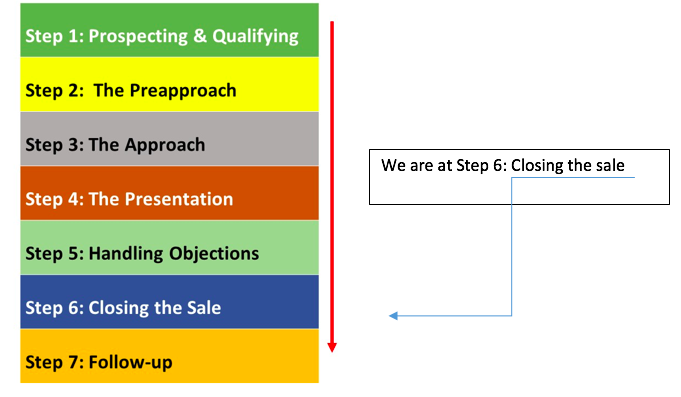12.1. Closing as part of the selling process
“Remember, if you don’t ask, you don’t get. You would not believe the number of salespeople who never ask the customer to buy. You don’t have to be a sales superstar with a bunch of stock closes. Saying things like “want to take it home?”, “OK with you?” or “should I write it up?” might be all the close you need” (Popyk, 2019, para 7). Closing can be a simple process but it does need to be done. Think back to the sales process. The seven step process introduced in Chapter 7.

Closing should be the easiest step if you have followed the process. You have done your research on your prospect (Step 1 & 2), determined the right approach (Step 3), handled all of their objections as they have come u (Step 5), trial closed and so now, the prospect has no reason not to want to buy whatever you are selling. Right? This is the theory. It does not always work this way. There are reasons why closes don’t happen in a sales call. Can you think of any? Trust is one—if you have not established rapport through your research and approach (think communication styles and techniques) or perhaps you did not qualify the prospect correctly or perhaps you did not answer the objections during the presentation or quite simply, perhaps you did not use active listening and misunderstood the customer needs.
Harvard Business Review surveyed 230 businesses and here are the top 7 reasons why a sales call fails to close: (Martin, 2017)
- The salesperson is not trustworthy or respected. So, using good communication skills and doing your research will help build trust and respect.
- Salespeople don’t know how to talk effectively with senior executives. Again the focus is on communication and doing your research on your prospect. The survey noted that fewer than one out of three salespeople could hold an effective conversation with senior executives
- The salesperson cannot clearly explain how their solution helps the buyer’s business. The salesperson needs to be very clear on the BENEFITS of the product or service (not just features) and then able to communicate that into solutions specific to the customer.
- Salespeople are too self-centered. The survey revealed that customers feel the salesperson may not have their best interest in mind. Again, salespeople need to communicate the benefits for the customer clearly and focus on the relationship.
- Salespeople are using the wrong closing strategy. It is important to customize your sales presentation and in particular, the close to the customer. We will look at closing techniques in this chapter.
- Salespeople don’t reduce the feeling of risk with buying their solutions. Salespeople need to communicate the benefits clearly and help reduce skepticism. Take the time to build a relationship.
- Salespeople cannot establish a personal connection to the buyer. Again, communication styles, research and knowing your product or service well (doing your research) will help build a connection and bring you closer to a close and a sale.
This short survey demonstrates the value of building trust, focusing on communication techniques, and understanding the value from the customer’s perspective. We learned all of these techniques in the chapters leading up to this one. The bottom line is that “you don’t need to be a good closer. You need to be a good asker. You need to be a good listener. Get the customer to talk.” (Popylk, 2019, para 4). One technique is to develop a list of 15 to 25 questions that help uncover needs and problems so that you can learn how to translate your product or service into benefits. Some suggestions include (Gitomer, 1995):
“What has been your experience with….?”
“What makes you choose….?”
“What do you like about ….?”
“What one thing would you improve about…?”
“How do your customers react to….?”
So, you have done your research and followed the 7 step process to selling and are at the closing of the sales presentation. Now what? The next section outlines different closing techniques.

